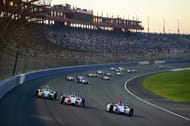Indycar racing has encountered several issues with its official name, which has been changed a number of times since its inception.
Indycar is an open-wheel professional automotive racing championship-sanctioning organisation in the United States, primarily deriving its name from the Indianapolis 500 race – the crown jewel of American motorsport -- also known as Indy 500.
IndyCar, also known as Indy Racing League (IRL), sanctions four races as a part of the Mazda Road to Indy ladder system, with ‘Indy’ referring to the Indy 500 race which takes place at the Indianapolis Motor Speedway. The four races sanctioned by IndyCar in order from the lowest to the highest rung in the series are the USF2000 National Championship, Pro Mazda Championship, Indy Lights and IndyCar Series.
The champions of the two highest rungs – IndyLights and the premium IndyCar Series – qualify to compete in the Indy500 race.
In 2010, motoring giants Mazda came up with a development scholarship system which would see commendable drivers and their teams being given a scholarship and place in a higher rung competition. This attracted a lot of new drivers to a racing championship whose prominence had decreased over time as it overshadowed by the success of the Formula 1 racing.
The CART-USAC divide
In the early 1990s, the term ‘Indy Car’ was being used by an organisation called Championship Auto Racing Team (CART) to describe the racing cars in the events sanctioned by them. Back then CART was a dominant sanctioning body for open-wheel racing in the country, however, the Indy500 races were sanctioned by another governing body known as the United States Auto Club (USAC).
The Indianapolis Motor Speedway registered and patented the term ‘IndyCar’ and licenced it to CART, which renamed its race to IndyCar World Series. Although CART didn’t sanction the Indianapolis 500, they awarded points which were accumulated from 1983-1995 to the drivers.
These points would help them become eligible for the CART Championship as a majority of Indy500 entrants were CART-based teams.
Initiation of the Indy Racing League and decline of CART
In 1994, the Indianapolis Speedway owner, Tony George, started a new racing series called the Indy Racing League (IRL) with Indy 500 as its premier attraction and the final race. This move was met with widespread criticism as the new-found race didn’t uphold a high stature in the CART structure and also due to the numerous desertions from the drivers, who found NASCAR to be more appealing.
The year 1995 saw rising tension between the CART and Indy Racing League as the former scheduled many of its races to conflict with those of the latter. Tony George gave a brilliant comeback in response to CART’s move by deciding to reserve 25 of 33 pole positions at Indy500 for the top 25 racers in the IRL and only eight poles for CART-racers, who were otherwise unable to participate in the IRL races due to conflicting race dates.
This was a bold move for one of the most revered racing competitions in the history of the sport.
CART tried to boycott the iconic Indy500 race, but only to fail miserably. They introduced a new alternate in US 500, which failed to grab much attention and was shut down after just one season.
In 1996, CART and Indianapolis Motor Speedway faced each other in a legal battle for the term ‘IndyCar’, which resulted in a fall-out between the two.
Both the organisations filed lawsuits against one another to prevent the use of the term which had been earlier licenced by the Motor Speedway to CART. Following the lawsuit, CART had to give up the use of the term ‘IndyCar’ altogether in the USA and the IRL couldn’t use it for the following six years.
IndyCar rightfully receives its name back
Owing to the change in engines and cars in the following years, none of the CART teams participated in IRL till 2000. By 2003, when the IRL changed its name to IndyCar Series, most of the famous CART teams had already moved to the competition.
Amidst the growing popularity of the IndyCar Series, CART owners declared bankruptcy in 2004. CART car owners ended up purchasing the infrastructure and rights to the competition and also renamed it the Champ Car World Series, although that arrangement wouldn’t last long as IndyCar offered them a unification deal in 2008.
This signalled the end of a 12-year split between the two and led to the creation of a single open wheel championship which came to be known as the IndyCar Series.
Two years later, the sanctioning body was renamed to ‘INDYCAR’ but just for promotional and trading purposes, all their legal and official documents hold the name ‘Indy Racing League LLC’ whilst stating that they also do business as ‘INDYCAR’.

